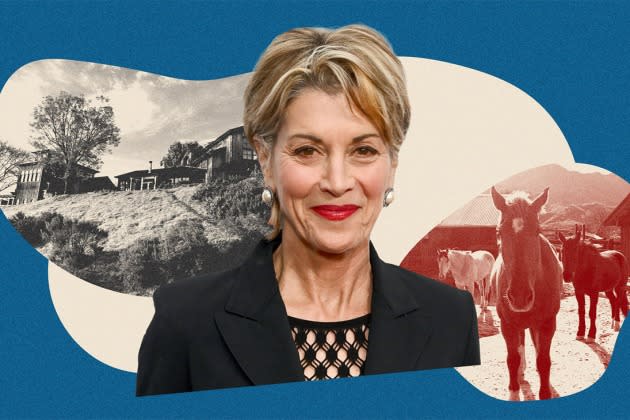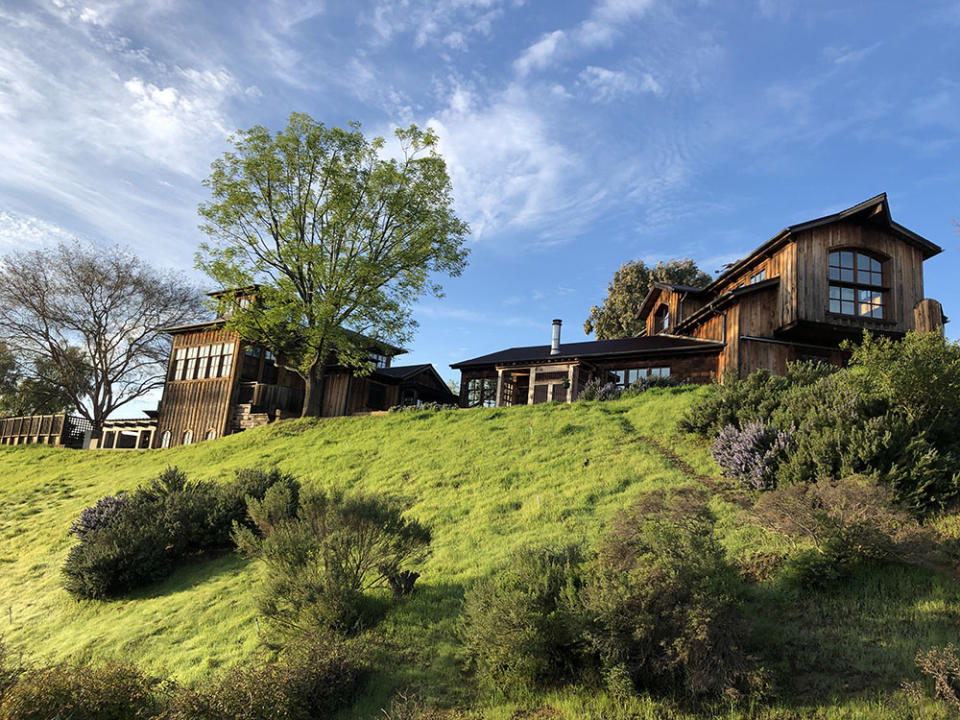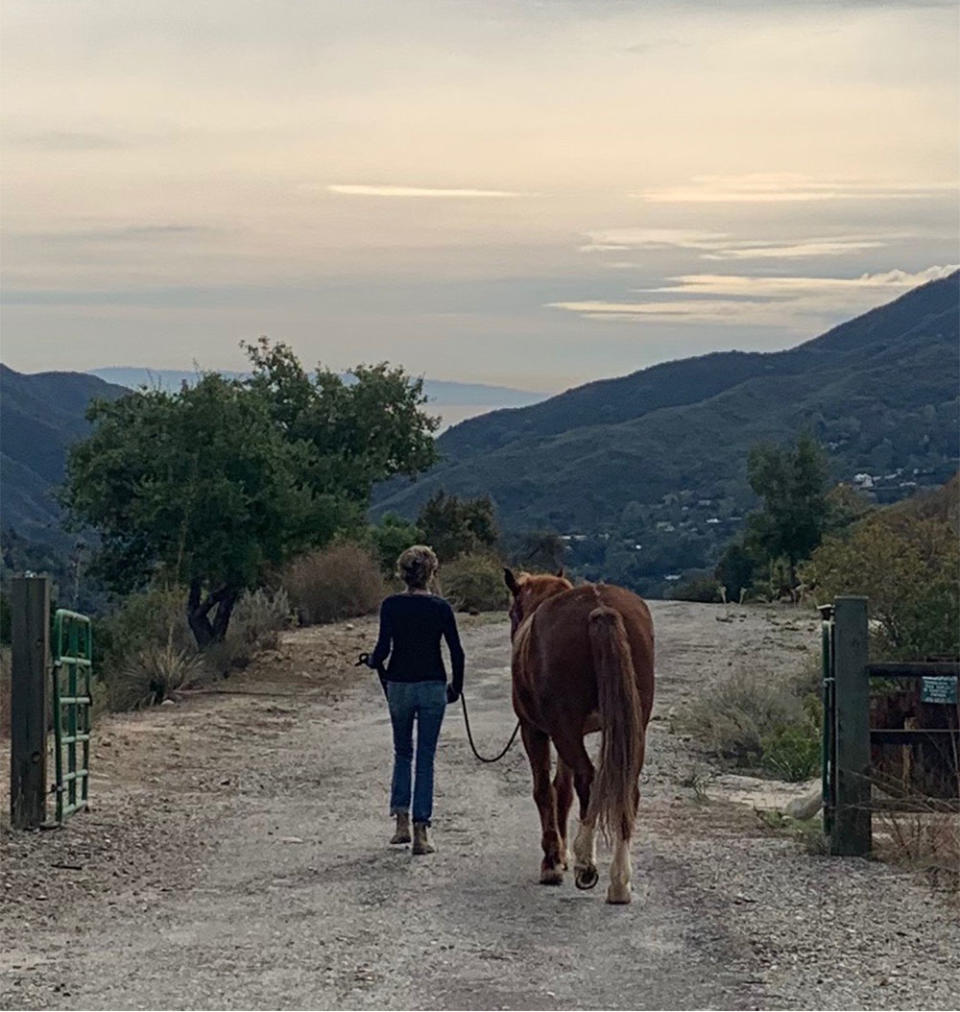“Connected to the Land”: Inside Wendie Malick’s Remote, Sustainable Lifestyle
- Oops!Something went wrong.Please try again later.

This story is part of The Hollywood Reporter’s 2023 Sustainability Issue (click here to read more).
Throughout a career spanning more than 30 years, actress Wendie Malick has lived tucked away on a hillside in Topanga Canyon for more than two of those decades, happily enjoying a life beyond the buzzy lights of Hollywood. Close enough to commute for work but distant enough to be surrounded by silence, Malick and her husband Richard Erickson live on 50 acres of fairly untouched land with their horses, dogs and favorite trees.
More from The Hollywood Reporter
Hollywood Courts Wall Street's ESG Investors Mainly With Film and TV Messages, Not Carbon Offsets
'A Matter of Degrees' Co-Host: Hollywood Needs More Climate Stories
Good Energy Expands to Incorporate Sustainability Consulting and Workshops
“We’re students in this whole movement, [and] we try to stay open to how we can better serve this land,” says Malick, an Environmental Media Association board member. The actress spoke to THR about her longtime sustainable lifestyle, how she built an eco-friendly home and how she’s still working on “moving toward a better footprint.”
What inspired you to leave the geographic limits of Hollywood and embrace an off-the-grid lifestyle?
I think it started when I was a kid; we had a big summer cottage on Lake Erie in Canada. Behind it was this Carolinian forest, and my mother always referred to it as a “cathedral of trees.” So I had this amazing, magical childhood where I would spend every summer with this forest all around me, [with] sand dunes going down to the beach. … I think that’s when I first got really into living in nature and feeling the power and majesty of it. Sleeping on the beach, looking up at the stars and wondering, “So what’s beyond that? What is infinity? What’s on the other side of this?” It was this whole cosmic awakening as a kid, and I think it just really had a lasting impact.
What did the process of finding your home in Topanga Canyon look like?
I had been living in town in various places. I lived in New York for 17 years, and when I came to L.A., I lived in a little house on Malibu Road, and then lived in Benedict Canyon and West Hollywood. When I met my husband, Richard, he was very keen on getting out of the city. And through friends, we had an opportunity to come and live in their cabin here in Topanga on their ranch. We fell in love with this whole place, and the idea of being able to have dogs and horses and come home to a place that reminded me of my childhood was a dream I never thought I’d realize.
So over time, we kept our eyes peeled, and we found this property that we bought; there was an existing cabin there that my husband renovated. This was in 1993. And I learned how to ride a horse. I didn’t mind living in tiny little cabins. I actually found it kind of charming, like living in summer camp all year round.

When you and your husband first bought the property and moved to Topanga, do you recall what conversations were like surrounding sustainable living and living off the grid at that time?
I love what I do for a living — I love going to set and hanging with people and getting dressed up and all of that. And I love coming home to this place where you can go to the post office in your pajamas, and everybody knows your name. There was something that was really appealing to me about the balance of this life.
It took many, many years for us to do plans and figure out the house we ultimately wanted to build. But when we built our house, I had been to Sundance the year before [where] the institute has Western prairie-style [buildings] and lots of verandas and natural wood. Richard would build me these little models to show me what it was going to be like because I’m not good at looking at plans; I need things three-dimensional. We perfected what we wanted this to be, and it is the most wonderful space I’ve ever lived in in my life.

On a practical level, through that process of 3D models, how did you construct it to be a sustainable home? What elements did you incorporate?
We have a huge solar array. So even though the property is not fully solar-powered because it was already hooked up to a conventional electricity source, most of [the energy] can come out of the solar array. So our bills are very low. We also did radiant heat on the floors, which means that you actually have hot water pipes under your floors. We have all stone and brick floors, and you can go barefoot on it. We didn’t air condition the great room — the kitchen and living area — because we’ve got really good fans. We are also on a well; it makes you so mindful of water when you’re on a well, [but] all of us in California and arid areas have to be mindful of that. Ten years ago, we had to go deeper, another 100 feet, because our aquifer dried up.
What are the distinctions between living this life now compared to how things used to function living in Los Angeles proper?
I think the biggest change is how connected you are to the land. There is a connection that I have to every tree on this property; it’s very different from having lived in New York and having lived in town. I had a house in Beverly Glen before we moved to Topanga, which was helpful, but it still was cheek by jowl with other houses, and I realized just how fortunate we are that we can be in the country and still just a spit away from a camera when I have to work. I call Topanga “the nearest faraway place.” My nearest neighbor is a quarter-mile away.
What’s it like commuting to and from L.A.?
I’m always thrilled when I can work at either Radford or Fox Studios because they’re the closest. That’s why I love early calls. I would much rather go in at 5:45, 6 in the morning, than have a 9 or a 10 a.m. call. That’s when it’s kind of brutal.

During your time in Hollywood, how have you seen attitudes change with regard to sustainability?
I remember years ago, we were talking about doing the EMA Green Seal [a recognition program honoring progress in sustainable production]. It was just an idea floating around for a while, and then all of a sudden it really did take hold and became something that big studios wanted to be part of. It was so exciting.
I also came to the realization a couple years ago that I’m going to wear dresses over and over again. I can go shopping in my own closet. I have enough stuff. It’s sort of like honoring the mature part of your closet. For those of us who are in our third act, you want to sort of honor and recognize the things that got you here. And sometimes it’s your wardrobe, too.
Do you have any predictions about where you think people’s habits and choices are headed, whether that’s people working in entertainment or Californians more generally?
I’m really encouraged and surprised by how many people are starting to go plant-based, including myself. I’ve been a pescatarian for the last 30 years, but the more I’ve learned through some of our documentaries at EMA, the more I’ve learned about the state of our fisheries — it’s really hard to find fish that are actually healthy for you and sustainable. So I’m eating much less fish and am really starting to embrace more vegetarian and vegan food, and it’s getting so much better. Now there are so many new restaurants and new options in terms of cooking, recipes, and much less expensive products.
Interview edited for length and clarity.

